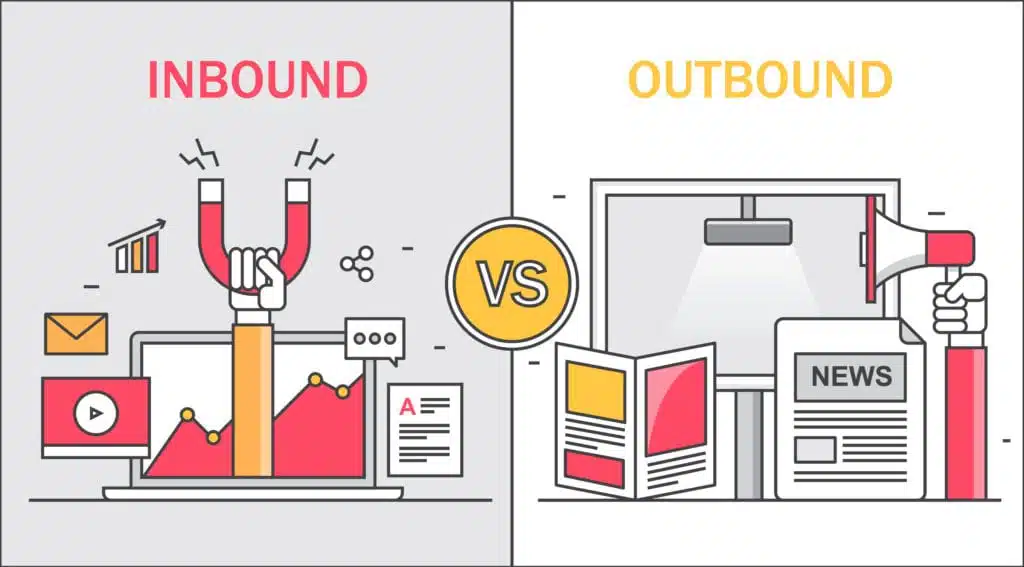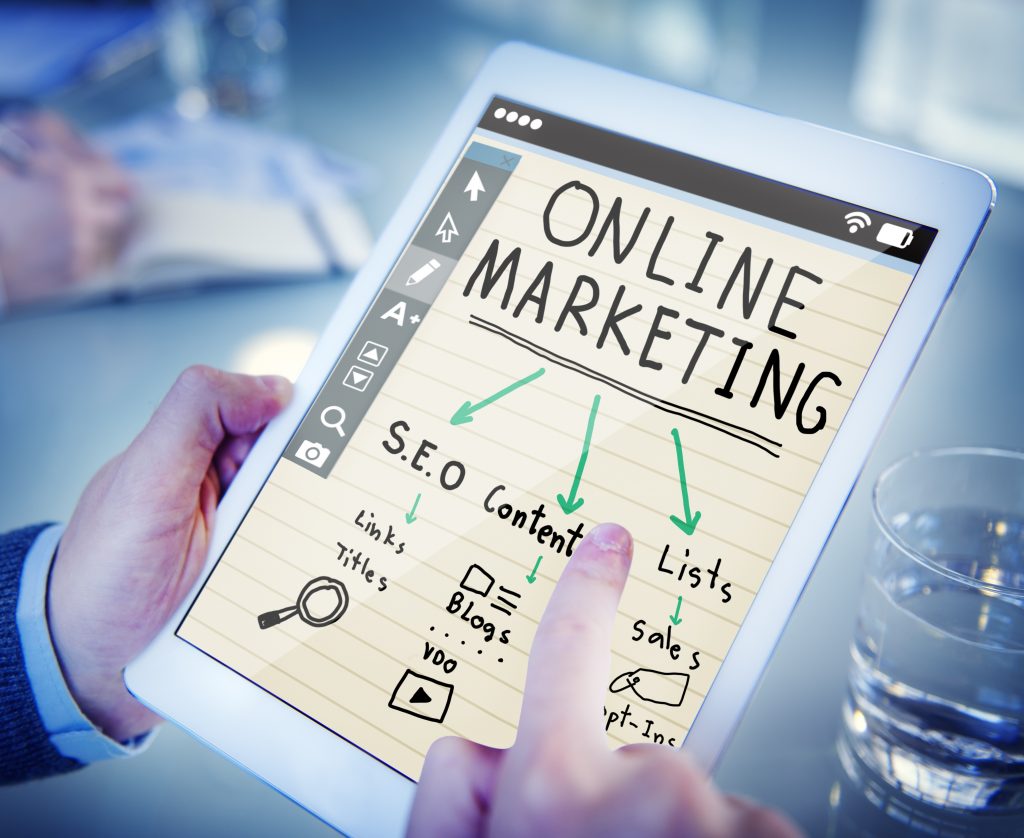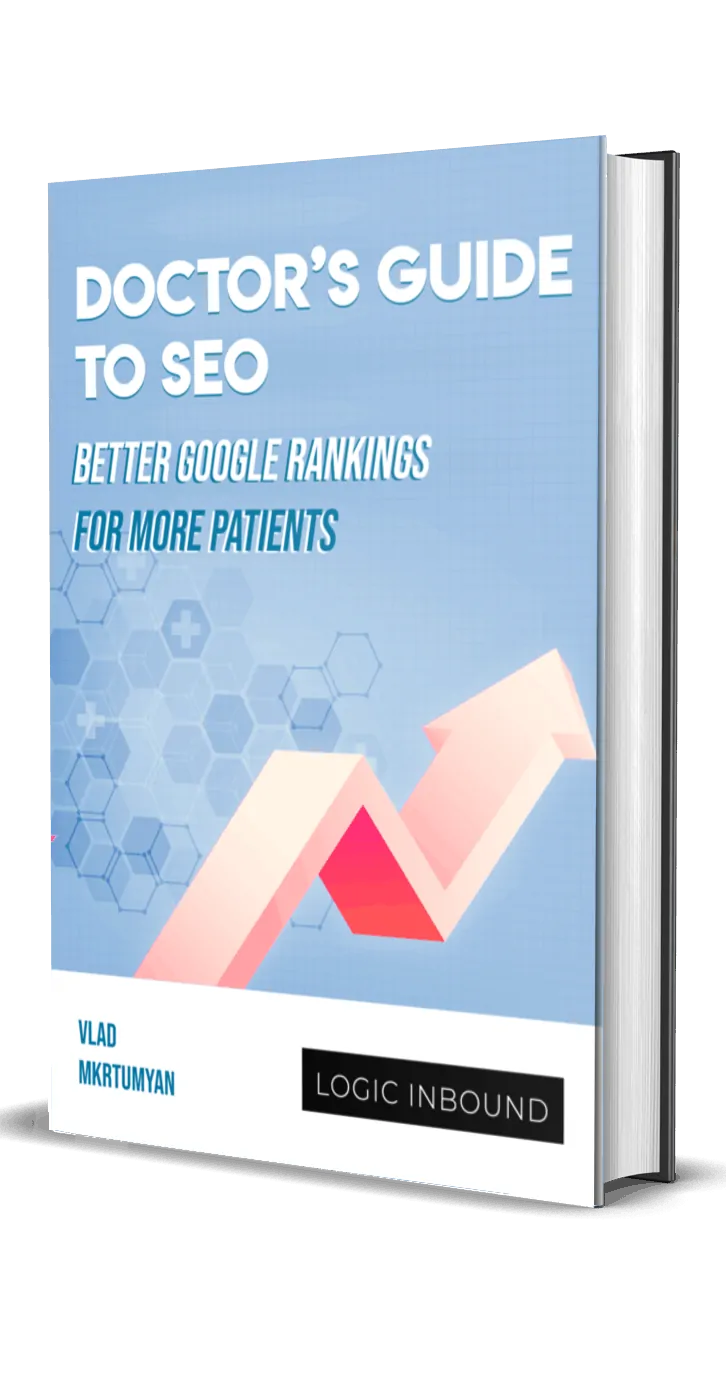A Comparison of Inbound Marketing vs Outbound Marketing
There’s inbound marketing.
There’s outbound marketing.
But what is the difference between the two?
Can you implement both inbound and outbound marketing within your campaign?
In this blog post, we’ll dissect inbound marketing vs outbound marketing for you.
From there, you’ll be able to decide which technique better suits you and your business.
An Overview of Marketing
Marketing is such a common and universal factor in the world of business that it seems to not even necessitate an explanation. The concept of marketing is so deeply embedded into the backbone of business that everyone in the industry understands its purpose, at the bare minimum.
However, not everyone who deals with marketing in their day to day professional life studied it in school. Marketing used to be concentrated to a specialized department within businesses, handled strictly by the marketing team. Its popularity has transformed marketing into a tactic that all people should know about, no matter what position they hold in the business world.
Marketing is becoming a part of every line of work. From lawyers to dentists, and especially entrepreneurs to startups, marketing is a must have in the business models, no matter the industry. Anyone who runs a business can profit, both financially and intellectually, from a crash course in marketing.
Now, our blog post focuses on the two overarching categories of marketing: inbound and outbound. For the sake of explaining the difference between inbound and outbound marketing, let’s dive into a brief overview of marketing in general.
Marketing refers to the advocacy of businesses and services, be it through advertisements, SEO campaigns, or online promotional tools. There are many different marketing methods out there. They all resemble similar features, but more noticeably, all forms of marketing have the same intention. Marketing methods strive to spread the word about a business in order to drive traffic, increase clientele, and expand monetary growth.
The two forms of marketing that we are focusing on are inbound and outbound marketing. We will explore the differences that set the two apart as well as the similarities that they have in common. To start, let’s briefly explore the ways by which they compare and contrast.
What Are The Differences Between Inbound and Outbound Marketing?
That question is outstanding.
We’re glad you asked.
The answer is a bit more complex so we will thoroughly compare and contrast inbound with outbound marketing.
They share many similarities, but the main contrasting element that creates the disparity is the approach each form takes. In a way, the difference comes down to perspective. Inbound marketing targets a condensed and particular audience. Outbound marketing addresses a much wider population inclusive of just about everyone. As with everything, there are benefits and detriments behind both types of marketing.
If you think about marketing as an invitation, inbound marketing applies to the people who have RSVP’d to the private event. They want to, and fully intend to, be present at the party.
Outbound marketing, on the other hand, is more applicable to large festivities that just about anyone can attend. There are no restrictions in terms of demographic. These attendees do not need an invitation because there is open access, similar to a music festival or a concert. There are minimal restrictions, like presenting a pre-purchased ticket at the doors and abiding by security rules while at the venue.
To reiterate, Inbound marketing is comparable to a private party, whereas outbound marketing can be viewed as a public event.
Now let’s dive further into the differences in approach between inbound and outbound marketing. We will also address the uniqueness of both forms of marketing, leaving you with a well-rounded understanding of the distinction by the end of this article.
What is inbound marketing?
Inbound Marketing Definition
Now that you have had a brief review of marketing in general, it is time to zero in and focus on specifics. So, what exactly is inbound marketing?
Inbound marketing is defined as a marketing technique, centralized to the internet, that captures the attention of customers within a defined demographic. These methods pull people in as they search for particular content instead of actively looking for customers or seeking them out from the crowds.
Inbound marketing has even been called the millennial form of marketing due to its recent uprising among businesses. It is currently the preferred form of marketing of today’s digital marketing agencies worldwide. The term refers to its newness in the marketing world, in comparison to outbound marketing. Up until the rise in technological usage and advancements, outbound marketing was the preferred, not to mention sole, way of reaching clients.
Inbound marketing becomes more technical in certain aspects too. Inbound marketing incorporates internet-based algorithms as well as user-friendly content to turn potential buyers into loyal customers. You can think about inbound marketing as targeting a smaller population of people, and these people already exhibit an interest in your services or products.
Inbound marketing incorporates strategies like SEO, which directs web traffic towards your website, and keyword research, which helps your site become visible to potential customers. By paying attention to the analytics pertaining to online searches, search engine optimization was constructed as a viable way to make websites more visible in search engine results pages (SERPs). When your SEO remains consistent, your website ranks higher on SERPs, which in turn elevates your chance of receiving website clicks and views.
Inbound marketing examples
- Social media posts
- Emails sent to subscribers
- Creating and updating a blog
- Targeting keywords in your written content
- Online presence via a professional website
- Introductory conferences and meetings
- Links and backlinks that elevate the SEO of your website.
- Basic on-site SEO
- Attention-grabbing titles
- Relevant and eye-catching headers
- Persuasive and error-free content
- Keyword research and implementation
- Appealing meta-descriptions
- Images with alt-tags
Positive Aspects of Inbound Marketing
- Web-based. Content posted online is globally accessible. The convenience of the internet makes inbound marketing an ideal way to connect with customers and clients without geographic limitations standing in the way. Since the information is digital, anyone with internet connection can view your content. Also, aspects like SEO (search engine optimization) and CRO (conversion rate optimization) narrow down the demographic. Your audience members are people interested in your products and services. You don’t have to hope they are interested. Inbound marketing only targets those who are.
- Lower costs than traditional outbound marketing. Since inbound marketing is primarily internet-based, the costs remain very low. There is no price to pay when piloting social media accounts, like Twitter and Instagram, for your business. Social media platforms are free of charge, meaning you do not need to allocate fractions of your budget for marketing. Some website hostings charge a monthly or annual fee, but not all do. There are hosting sites – like Wix, Volusion, Shopify, and Squarespace – that offer basic plans for free.
- Less intrusive than outbound marketing. Inbound marketing is more readily welcomed by the public, in the sense that people opt into receiving information via inbound marketing. Outbound marketing, in contrast, involves cold calls and pieces of mail that the receiver may not even hold an interest for in the first place. Permission is necessary in order to move forward.
- Passive and continuous results. While you do need to update the SEO of your website every so often, it is very sporadic. A huge bonus of inbound marketing is its passiveness. Positive results take a few months to stabilize, but once they do, the trend continues and your website receives continuous traffic. When your website is recognized by Google, it remains in its knowledge base, so your recognition only increases from there. You do not have to go out everyday and actively search out viewers for your website because SEO is constantly helping your website become visible, without your active participation.
- Potential for content to gain immense popularity and end up going viral. The internet is a magical place where news spreads rapidly. Online content has the capacity to be shared all over the world in a matter of minutes. Information can be reposted from one website onto another, allowing for people on multiple different platforms to view the content. This versatility does wonders for your website because it increases your audience.
Challenging Areas of Inbound Marketing
- Patience is the most important value to encapsulate when choosing the route of inbound marketing. Inbound marketing is a process that yields profitable and motivating results, but these results are not immediate. While overnight success is possible, it is very rarely the case. That said, it is vital that a company has this understanding before embarking on a digital marketing campaign that utilizes inbound marketing strategies. Inbound marketing takes an immense amount of devoted time and effort.
- Requires a larger team of individuals who specialize in certain areas. In theory, it sounds like you could easily allocate your own time to cover the roles of an SEO expert, content creator, and development strategist. You may be thinking, “How hard could it be to include keywords and write text for your website?” However, it is so much harder than that. Once you attempt to do it all on your own, you will come to realize the gravity of the work. Inbound marketing requires an extensive knowledge base. To make sure every aspect is covered, and all duties are fulfilled, it is in your best interest to hire an individual for each position. Logic Inbound advises you employ someone whose sole purpose is to oversee and manage the marketing of your business.
- Recognition takes time. Going viral is a dream come true for anyone with inbound marketing on their side because it produces an influx in viewers all at once. However, catching the eye of millions of online users at the same time is not the typical outcome. As long as you actively post to your social media accounts and blogs, your business will earn a following over time, so patience is key.
- Requires updates to stay current on search engine algorithms and preferences. Your SEO campaigns and inbound marketing tools must be updated if changes to search engines occur. You may also need to increase the relevance and authority of your web pages to rank higher than competitors. Periodically checking where your site ranks on SERPs is important, too. Luckily, you have the ability to see where you rank on Google at any time. By inputting your keywords into the search engine, you can monitor your own ranking status, no matter where you are.
- Competitive. With everyone turning to the internet, there are more websites and businesses with an online presence now more than ever before. This reality makes it more difficult to stand out and promote yourself as the leading business in your industry. The purpose behind backlinks and guest blog posts is to create online connections. These connections forge relationships between you and the owners of said websites. They have viewers of their own, and by collaborating with another website, their users are sure to see your content and make their way to your website. In today’s world, connections increase your odds of being noticed. You will not have to push so fervently for recognition when you have connections with other businesses.
What is outbound marketing?
Outbound Marketing Definition
Outbound marketing is the term for traditional marketing, resulting from the creation of inbound marketing. The new title originated after inbound marketing was well-regarded as an alternate form of marketing. In essence, outbound marketing is a technique that survives on active outreach and individual communication, rather than passively waiting for customers to find you and your business.
Outbound marketing does not have a target demographic in mind. It is a more widespread method of exposing your products or services because there is no limitation in terms of audience. While it is effective to an extent, outbound marketing relies heavily on chance and less on intentionality.
A massive billboard, for example, is a prime case of outbound marketing. Billboards are very hard to miss when they are in your line of vision. However, in order to see them, your potential customers must be driving along the roads they are placed along. People also have to look up and redirect their sight away from traffic and towards the message written across the billboard.
Then again, even if someone views your billboard, the likelihood that they are inclined to further research your business is slim. Not only do they have to have the intrinsic desire to want to learn more about you, but they also have to actively gather more information on their own. This is a baseline deterrent for many people, especially in our digital age of immediate access.
In a world where everything is instant, you must work to align your promotional exercises with people and their expectations. You go out on a whim when you elect to promote your business through outbound marketing because, to the modern era, it seems outdated. Most forms of outbound marketing are physical, rather than technological and digital.
Outbound marketing examples
- Billboards
- Television commercials
- Advertisements broadcasted on the radio
- Press releases
- Segments in newspapers
- Brochures and magazines
- Mass email campaigns
- Door-to-door sales
- Cold-calls
- Letters and brochures sent via mail
- Branded swag, like pens, notepads, lanyards, et cetera
Positive Aspects of Outbound Marketing
- All-inclusive. Outbound marketing does not target a certain group of people. Instead, it reaches the general public. This can be a good thing when there are people out there who may not think to search for your services in the first place. If you come to them, you will be noticed, whereas otherwise you may have never crossed their mind.
- Personal touch and connection. Outbound marketing creates a line of communication and forges a relationship between consumer and provider. Phone calls, in-person discussions, and physical forms of advertisement are more personal than online content. Establishing a relationship through verbal dialogue is more meaningful than texts and emails.
- Appeal to the less tech-savvy consumer. Outbound marketing makes use of tactile, in-person strategies. People who are less prone to using technology will be more inclined to support companies whose marketing is tailored to their offline preferences. Even though society is more technology-based than ever, not all people have adapted this lifestyle, especially individuals of older generations.
Challenging Aspects of Outbound Marketing
- Outreach has its drawbacks. Reaching out to people about a service is tricky because you have to put yourself out there. Professional interactions are lowered to an even less secure level when outreach is involved due to the wealth of uncertainty in outreach. When a business blindly reaches out to someone, the business has no idea if the individual is remotely interested or a viable candidate for their service. his heightens the chance of the business being denied, which can become discouraging after awhile. Addressing such a broad audience is not always efficient because you spend time trying to appeal to people who are not interested, which distracts from those who are.
- Less security. As stated above, there is less security when implementing outbound marketing tactics. You end up relying on other people to be interested in what you have to offer. Your hope is that they will find interest in your brand, but you have no way of knowing from the beginning. Since the population is not narrowed down to a particular demographic, you will be trying to appeal to everyone. However, not everyone is interested. Your attempts could also go unnoticed by those who really are interested.
- Active and intentional. When selecting outbound marketing as your promotional technique, you are signing up for a very active form of advertising. When you stop actively reaching out and connecting, your campaigns stop, too. Unlike inbound marketing, outbound marketing does not have any passive benefits, like visitors to your website overnight or content going viral in a short period of time. There is a limit on the growth you can receive from outbound marketing. The minute you stop active outreach, your campaign stagnates.
- Potential to turn customers away from your brand. It seems that people have developed an intolerance for commercials and advertisements. With television streaming apps like Amazon and Netflix, people no longer have to sit through interruptions during their TV shows. If you were to put together a commercial and have it play via cable TV or on sites that still include commercials, your advertisement could create a polar opposite effect. Instead of appealing to the audience, you may just end up pushing them further away, just because your promotion was in the form of a commercial.
- Blocking abilities for interruption-based marketing. The least favorable part of cold-calling and selling door-to-door is showing up unannounced. The nature of these two methods is abrupt and unexpected. Not everyone is comfortable with receiving phone calls from people they do not know. A lot of times, if strangers show up on someone’s doorstep, they will ignore the visitors, hoping they leave soon. Informing the public about a business via outreach is risky because there is no certitude as to whether or not you will get through to your potential customer. Do-not-call lists and “unsubscribe” options create barriers as well.
Marketing with Logic Inbound
As the name implies, Logic Inbound utilizes inbound marketing to improve the businesses of their clients and identify growth opportunities. Logic Inbound specializes in SEO, CRO, content marketing, web design, e-commerce store development, emails, social media advertising, and influencer marketing. To find out how Logic Inbound can help you, contact the digital marketing team of SEO experts here.



